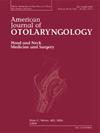乳突封堵用骨粉混合浓缩生长因子
IF 1.7
4区 医学
Q2 OTORHINOLARYNGOLOGY
引用次数: 0
摘要
背景乳突封堵术是治疗慢性耳部手术的有效手术步骤。乳突填塞技术包括用自体组织和/或骨软骨材料填充腔体,然后移除乳突空气细胞。目的本研究的目的是显示乳突封堵使用的CGF和骨粉的混合物的优势。材料与方法用仪器采集健康乳突皮质骨粉。将收集的骨粉与CGF混合形成凝胶。然后行乳突腔和上腔封堵术。结果15例因胆脂瘤行乳突管壁下切除术的患者纳入研究。所有患者耳塞后均获得目标外耳道及听力结果。结论乳突切除术后建立自然外耳通道是一种有效的手术技术,适用于乳突闭塞、慢性耳部感染和胆脂瘤的CGF治疗。骨粉与CFG混合的乳突封堵术是一种创造自然健康外耳道的有效手术技术。本文章由计算机程序翻译,如有差异,请以英文原文为准。
Mastoid obliteration with bone dust mixed with concentrated growth factor
Background
Mastoid obliteration is a useful surgical step in the treatment of chronic ear operation. The technique of mastoid obliteration involves filling the cavity with self-tissue and/or osseocartilaginous graft material, following removing the mastoid air cell.
Objective
The aim of this study is to show the advantages of mastoid obliteration using a mixture of CGF and bone dust.
Material and method
Bone dust was collected with an apparatus from the healthy mastoid cortex. Collected bone dust was mixed with CGF to form a gel. Then, mastoid cavity and epitympanum obliteration were performed.
Results
Fifteen patients who underwent canal wall down mastoidectomy for cholesteatoma were included in the study. In all patients, the targeted external ear canal and hearing results were obtained after obliteration.
Conclusion
It is an effective surgical technique for creating a natural external ear path after mastoidectomy applied for mastoid obliteration, chronic ear infections and cholesteatoma treatment with CGF. Mastoid obliteration using bone dust mixed with CFG is an effective surgical technique to create a natural and healthy external ear canal.
求助全文
通过发布文献求助,成功后即可免费获取论文全文。
去求助
来源期刊

American Journal of Otolaryngology
医学-耳鼻喉科学
CiteScore
4.40
自引率
4.00%
发文量
378
审稿时长
41 days
期刊介绍:
Be fully informed about developments in otology, neurotology, audiology, rhinology, allergy, laryngology, speech science, bronchoesophagology, facial plastic surgery, and head and neck surgery. Featured sections include original contributions, grand rounds, current reviews, case reports and socioeconomics.
 求助内容:
求助内容: 应助结果提醒方式:
应助结果提醒方式:


